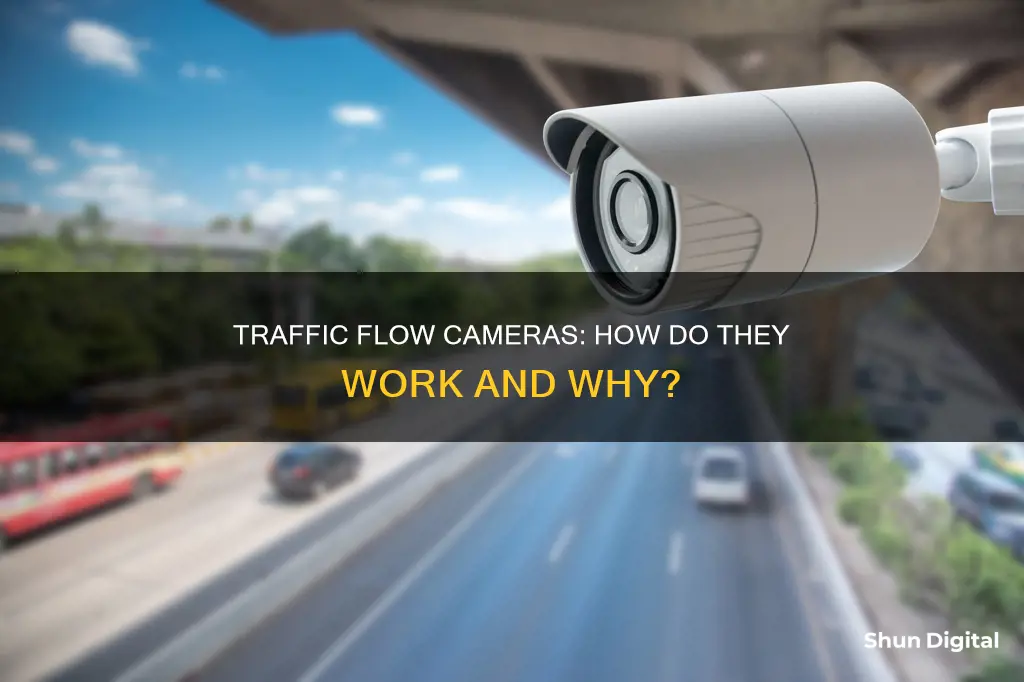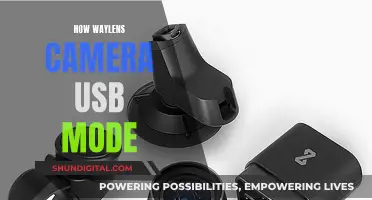
Traffic flow cameras are a type of video camera used to observe and manage vehicular traffic on roads. They are typically installed at busy intersections, highways, freeways, and arterial roads to monitor traffic patterns, gather data, and improve traffic flow. These cameras are often mounted on high poles, traffic signals, or streetlights and are connected by optical fibres with a consistent power supply to ensure uninterrupted imagery. While some traffic flow cameras are used for law enforcement, such as red light or speed cameras, others focus on traffic management and are not tied to any enforcement system. These cameras help determine traffic light timing, provide situational awareness to authorities, and can be used to investigate accidents or crimes. With the development of machine learning and deep neural networks, traffic flow cameras are becoming more advanced and able to detect and classify vehicles in real time. Overall, traffic flow cameras play a crucial role in improving road safety, efficiency, and the overall driving experience.
| Characteristics | Values |
|---|---|
| Purpose | Observe vehicular traffic on a road |
| Placement | Along major roads such as highways, freeways, expressways, arterial roads, and intersections |
| Power Source | Mains power in urban areas, solar panels or other alternative power sources |
| Function | Measure traffic flow, determine traffic light timing, provide data for future road development and construction work, assist with crime prevention and investigation |
| Type of Camera | Video camera, dome-shaped, cylindrical, or enclosed in a weatherproof housing |
| Data Transmission | 4G LTE transmission technology |
What You'll Learn
- Traffic flow cameras are used to detect and differentiate between vehicles and bicycles at intersections
- They help engineers monitor traffic flow in real time
- They are placed at common congestion points to provide information on poor traffic flow
- They can be used to record traffic patterns and gather data
- They can be used to detect traffic violations

Traffic flow cameras are used to detect and differentiate between vehicles and bicycles at intersections
Traffic flow cameras are an important component of intelligent transportation systems, aiding in traffic monitoring and management. They are typically placed at busy intersections, along highways, and on major roads to observe vehicular traffic. One of their primary functions is to detect and differentiate between vehicles and bicycles at intersections, improving safety and traffic flow for all road users.
These cameras are often mounted on traffic signals or light poles, providing a bird's-eye view of the intersection. They employ machine learning techniques and video analytics to identify different types of vehicles and bicycles accurately. This technology is especially advantageous for cyclists, as it eliminates the need to push the bike button at intersections.
The data captured by these cameras offers valuable insights into traffic patterns, peak traffic times, and accident-prone areas. Transportation departments can use this information to make informed decisions about road development and construction, enhancing traffic flow and road safety. Additionally, in the event of collisions or other incidents, the live video feed from these cameras can assist dispatchers in coordinating a swift response.
It is important to note that traffic flow cameras are distinct from enforcement cameras, such as red-light cameras or speed cameras, which are used for issuing tickets and violations. Traffic flow cameras primarily serve a monitoring and data-gathering purpose, helping to optimize traffic signal timing and improve overall traffic management.
In summary, traffic flow cameras play a crucial role in modern transportation systems by detecting and differentiating between vehicles and bicycles at intersections. They enhance road safety, improve traffic flow, and provide valuable data for transportation planning and management.
Computer Camera Quality: Why So Poor?
You may want to see also

They help engineers monitor traffic flow in real time
Traffic flow cameras are an important component of intelligent transportation systems, providing real-time data on traffic conditions. They are typically placed at busy intersections, along highways, or on major roads to monitor vehicular movement. These cameras help engineers and traffic management authorities in several ways, especially in terms of monitoring traffic flow in real-time:
Visualising Traffic Flow
Traffic flow cameras provide a live video feed of intersections, roads, or highways, allowing engineers to visualise traffic conditions. This helps engineers to monitor traffic flow in real-time and make informed decisions. For example, if a traffic build-up is detected, engineers can take immediate action to manage the situation and prevent potential congestion.
Data Collection and Analysis
These cameras collect valuable data on traffic patterns, including peak traffic times and accident-prone areas. This data is then analysed to inform future road development and construction projects, helping to optimise road infrastructure and improve traffic flow.
Responsive Traffic Management
Engineers can use the real-time data from traffic flow cameras to adjust traffic light timing at intersections, providing a green wave for emergency vehicles or optimising flow during peak hours. This dynamic approach to traffic management helps reduce travel time for emergency services and improve overall traffic efficiency.
Safety and Incident Response
In the event of accidents or disruptions, traffic flow cameras enable engineers to quickly assess the situation and coordinate an appropriate response. This can include dispatching emergency services or activating safety equipment, particularly in tunnels or remote areas beyond the electrical grid.
Public Information
In some cases, traffic flow camera footage is made available to the public through websites or television broadcasts. This helps travellers make informed decisions about their routes, especially if they need to consider alternate routes due to congestion or incidents.
By utilising traffic flow cameras, engineers can make data-driven decisions to optimise traffic flow, enhance road safety, and improve the overall efficiency of transportation systems. This technology plays a crucial role in managing modern transportation networks and ensuring the smooth movement of vehicles.
Traffic Cameras: Do They Need Marking?
You may want to see also

They are placed at common congestion points to provide information on poor traffic flow
Traffic flow cameras are placed at common congestion points to monitor and observe traffic flow in real time. They are typically installed on high poles or masts above major roads such as highways, freeways, and arterial roads. By providing live video footage to a monitoring centre, these cameras help manage and optimise traffic flow, especially during peak periods, near schools, during construction, and during special events or emergencies.
Placed at common congestion points, traffic flow cameras can provide valuable information on the causes and severity of poor traffic flow. This data can be used to inform future road development and construction work, helping to optimise traffic flow and reduce congestion. The cameras can also be used to detect and differentiate between vehicles and bicycles, improving traffic light timing and overall traffic management.
In addition to managing traffic flow, these cameras can also assist with crime prevention and investigation. They can be used to record traffic patterns, gather data, and provide safety for workers and equipment at highway construction projects. With built-in transmission technology, users can benefit from full autonomy and remote access to live and recorded video footage, enabling situational awareness and improved decision-making.
Overall, traffic flow cameras placed at common congestion points play a crucial role in providing information on poor traffic flow, facilitating traffic management, and enhancing road safety and efficiency.
Surveillance Cameras in Dressing Rooms: Are They Legal?
You may want to see also

They can be used to record traffic patterns and gather data
Traffic flow cameras are an important component of intelligent transportation systems, and they serve various purposes beyond monitoring traffic. One of their key functions is to record traffic patterns and gather data, which has multiple benefits for traffic management and urban planning.
By recording traffic patterns, these cameras can provide valuable insights into traffic flow. They can identify areas of congestion and help determine the causes and severity of poor traffic flow. This information is invaluable for traffic management centres, which use it to monitor traffic during peak periods and around schools, as well as during construction, special events, and unexpected incidents. For instance, the City of Irvine uses traffic cameras to facilitate smooth and safe traffic flow, with their Traffic Management Centre monitoring traffic during peak periods and around schools.
The data gathered by these cameras can also be used to inform future road development and construction work. State transportation departments can analyse details such as peak traffic times and accident hotspots, and use this information to plan and optimize road infrastructure. This can lead to improved road safety and a reduction in traffic congestion.
In addition, the presence of traffic cameras can actively encourage safe driving habits and discourage moving violations. For example, WCCTV's mobile surveillance cameras are often deployed for crime prevention and investigation, targeting known hotspots for traffic violations.
Furthermore, traffic flow cameras can be used in combination with other technologies to enhance their effectiveness. For instance, they can be integrated with automatic number-plate recognition (ANPR) technology to track the whereabouts of drivers, or with emergency vehicle preemption (EVP) systems to prioritize the passage of emergency vehicles through intersections.
Overall, traffic flow cameras play a crucial role in recording traffic patterns and gathering data, which has a range of applications in traffic management, urban planning, and road safety.
Lightroom and Camera Raw: What's the Difference?
You may want to see also

They can be used to detect traffic violations
Traffic flow cameras are an important component of intelligent transportation systems, and they serve various purposes, including detecting traffic violations. These cameras are distinct from road safety cameras, which are specifically installed to enforce rules and capture still photos of violations.
Traffic flow cameras are often used by law enforcement agencies and government departments to prevent and investigate traffic violations. They can be placed at traffic signals, busy roads, intersections, or areas with a high incidence of illegal activities, such as illegal dumping. The presence of these cameras can act as a deterrent, encouraging safer driving habits and reducing the likelihood of moving violations.
One example of a traffic flow camera used for violation detection is the red-light camera. These cameras are usually found at busy intersections and are designed to capture multiple images of a vehicle entering the intersection on a red light. The recorded images serve as evidence, and the motorist receives a ticket in the mail for the violation.
Another type of camera that aids in violation detection is the speed camera. Similar to red-light cameras, speed cameras automatically detect and issue speeding violations. They are commonly placed on less populated back roads and in residential areas where speeding is a frequent concern. Speed cameras can be fixed, mounted on poles, or mobile, allowing for flexibility in their deployment.
In addition to visual evidence, some traffic flow cameras employ technologies like radar detectors and laser detectors to capture vehicle speed and potential violations. These tools work in conjunction with the cameras to provide comprehensive data for law enforcement purposes.
Overall, traffic flow cameras play a crucial role in maintaining road safety and reducing traffic violations. By utilising this technology, authorities can effectively monitor and manage traffic, ensuring that drivers adhere to the rules and regulations, ultimately creating a safer environment for all road users.
The Evolution of Smartphone Cameras: How Are They Made?
You may want to see also
Frequently asked questions
Traffic flow cameras are used to observe and monitor vehicular traffic on roads. They help to manage traffic flow, prevent and investigate crimes, and ensure road safety.
Traffic flow cameras are typically placed along major roads such as highways, freeways, expressways, and arterial roads. They are often mounted on high poles, masts, or traffic light poles at intersections.
Traffic flow cameras provide real-time data on traffic patterns, including congestion points, peak traffic times, and accident hotspots. This information is used to optimise traffic light timing and route planning, and to inform road development and construction work.







